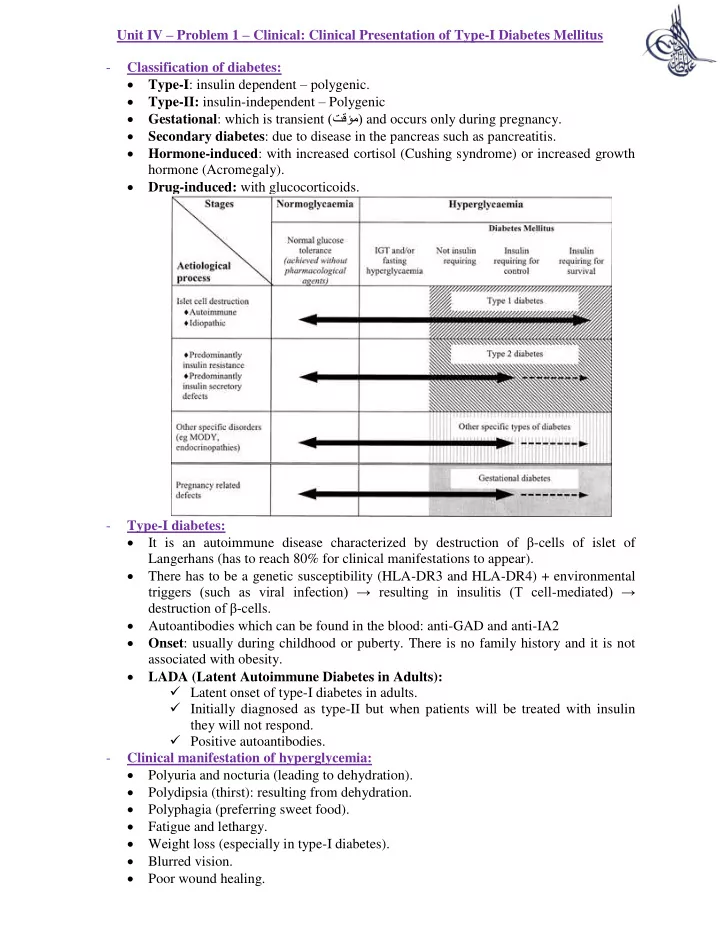

Unit IV – Problem 1 – Clinical: Clinical Presentation of Type-I Diabetes Mellitus - Classification of diabetes: Type-I : insulin dependent – polygenic. Type-II: insulin-independent – Polygenic Gestational : which is transient (تقؤم) and occurs only during pregnancy. Secondary diabetes : due to disease in the pancreas such as pancreatitis. Hormone-induced : with increased cortisol (Cushing syndrome) or increased growth hormone (Acromegaly). Drug-induced: with glucocorticoids. - Type-I diabetes: It is an autoimmune disease characterized by destruction of β -cells of islet of Langerhans (has to reach 80% for clinical manifestations to appear). There has to be a genetic susceptibility (HLA-DR3 and HLA-DR4) + environmental triggers (such as viral infection) → resulting in insulitis (T cell - mediated) → destruct ion of β -cells. Autoantibodies which can be found in the blood: anti-GAD and anti-IA2 Onset : usually during childhood or puberty. There is no family history and it is not associated with obesity. LADA (Latent Autoimmune Diabetes in Adults): Latent onset of type-I diabetes in adults. Initially diagnosed as type-II but when patients will be treated with insulin they will not respond. Positive autoantibodies. - Clinical manifestation of hyperglycemia: Polyuria and nocturia (leading to dehydration). Polydipsia (thirst): resulting from dehydration. Polyphagia (preferring sweet food). Fatigue and lethargy. Weight loss (especially in type-I diabetes). Blurred vision. Poor wound healing.
- Diagnosis of diabetes: Fasting blood glucose ≤ 7 mmol/L (needs conformation by repeating). Random plasma glucose < 11.1 mmol/L Oral glucose tolerance test (OGTT) < 11.1 mmol/L HbA 1c ≥ 6.5% Diabetic ketoacidosis: - It is a medical emergency associated with type-I diabetes. Cardinal biochemical features: Hyperglycemia. Hyperketonemia. Metabolic acidosis. Pathogenesis : lack of insulin leads to increased lipolysis with availability of free fatty acids which are used in the synthesis of ketone bodies. Clinical manifestations: Abdominal pain, nausea and vomiting. Blurred vision. Dehydration, which if severe, can lead to hypovolemia and hypotension. Tachycardia. Kussamal breathing (rapid and deep → this helps in washing out CO 2 thus compensating for metabolic acidosis). Fruity breath odor (due to acetone). if the condition is very severe, this can result in: confusion or even coma. Laboratory investigations: Arterial blood gases: to check if there is metabolic acidosis or not. Anion gap must be calculated to conclude that the patient is suffering from metabolic acidosis. How to calculate the anion gap? Anion gap = (Na + + K + ) – (HCO 3 - + Cl - ) What are the causes of metabolic acidosis with high anion gap? → MUDPILES:
M ethanol. U remia (indicating chronic renal failure). D iabetic ketoacidosis. P ropylene glycol. I nfection, Iron, Isoniazid. L actic acidosis. E thylene glycol. S alicylates. Urinalysis: looking for ketones. ECG (why?) → because hyperkalemia can lead to cardiac arrhythmias. Why is the total body potassium low? Due to polyuria (which leads to loss of potassium). These patients usually have abdominal pain and vomiting (loss of potassium). Why is the potassium high when we initially draw blood from the patient? Lack of insulin leads to accumulation of potassium extracellularly. In acidosis, H ions go intracellularly while the potassium goes to the extracellular compartment. Management? Hydration to replace the lost volume. IV insulin. If blood glucos e level drops don’t stop infusion of insulin, instead you can administer dextrose. Infusion of potassium.
Recommend
More recommend